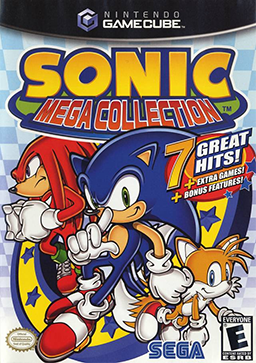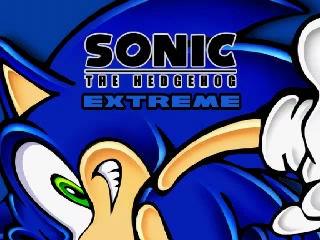Sonic Team is a video game developer owned by the Japanese video game company Sega as part of its Sega CS Research and Development No. 2 division. Sonic Team is best known for its Sonic the Hedgehog series and games such as Nights into Dreams and Phantasy Star Online.

Sonic the Hedgehog is a character created by the Japanese game developers Yuji Naka and Naoto Ohshima. He is the star of the Sonic the Hedgehog franchise and the mascot of the Japanese video game company Sega. Sonic is an anthropomorphic blue hedgehog who can run at supersonic speed, hence his name. He races through levels, collecting rings and avoiding obstacles, as he seeks to defeat his archenemy, Doctor Eggman. He is accompanied by supporting characters, such as his best friend and sidekick Miles "Tails" Prower, self-proclaimed girlfriend Amy Rose, and friendly rival Knuckles the Echidna.

Sonic Mega Collection is a video game compilation developed by Sonic Team and published by Sega in 2002 for the GameCube. It is a compilation of several Sonic the Hedgehog games originally released for the Genesis, along with a few other Sega-published titles for the system.

Knuckles the Echidna is a character from Sega's Sonic the Hedgehog series. He is a red anthropomorphic short-beaked echidna who is Sonic's secondary best friend and former rival. Determined and serious, but sometimes gullible, he fights his enemies using brute force and strength. His role is established as the guardian of the Master Emerald, a large gemstone which controls the series' integral Chaos Emeralds, and is the last living member of his tribe, the Knuckles Clan.

Sonic Heroes is a 2003 platform game developed by Sonic Team USA and published by Sega as part of the Sonic the Hedgehog series. The player races a team of series characters through levels to amass rings, defeat robots, and collect the seven Chaos Emeralds needed to defeat Doctor Eggman. Within each level, the player switches between the team's three characters, who each have unique abilities, to overcome obstacles. Sonic Heroes downplays the action-adventure and exploration-based gameplay of its predecessors Sonic Adventure (1998) and Sonic Adventure 2 (2001) in favor of returning to the linear style of Sega Genesis-era Sonic games.

Shadow the Hedgehog is a character created by the Japanese game developers Takashi Iizuka, Shiro Maekawa, and Kazuyuki Hoshino. He is a major character in Sega's Sonic the Hedgehog franchise. Shadow is an anthropomorphic black hedgehog created by Professor Gerald Robotnik, the grandfather of Doctor Eggman. Shadow shares design traits and attributes with Sonic the Hedgehog. He is an antihero who has good intentions but will do whatever it takes to accomplish his goals, putting him at odds with Sonic.

Sonic Adventure 2 is a 2001 platform game developed by Sonic Team USA and published by Sega for the Dreamcast. It features two good-vs-evil stories: Sonic the Hedgehog, Miles "Tails" Prower, and Knuckles the Echidna attempt to save the world, while Shadow the Hedgehog, Doctor Eggman, and Rouge the Bat attempt to conquer it. The stories are divided into three gameplay styles: fast-paced platforming for Sonic and Shadow, third-person shooting for Tails and Eggman, and action-adventure exploration for Knuckles and Rouge. Like previous Sonic the Hedgehog games, the player completes levels while collecting rings and defeating enemies. Outside the main gameplay, they can interact with Chao, a virtual pet, and compete in multiplayer battles.

Sonic & Knuckles is a 1994 platform game developed and published by Sega. Players control Sonic the Hedgehog or Knuckles the Echidna in their quests to save Angel Island; Sonic tries to stop Doctor Robotnik from re-launching his orbital weapon, the Death Egg, while Knuckles scuffles with Robotnik's minion, EggRobo. Like previous Sonic games, players traverse side-scrolling levels at high speeds while collecting rings and defeating enemies.

Sonic Advance is a 2001 platform video game developed by Sonic Team and Dimps and published by Sega for the Game Boy Advance. It was the first Sonic the Hedgehog game to be released on a Nintendo console with Sonic Adventure 2: Battle on the GameCube, and was produced in commemoration of the series' tenth anniversary. The story follows Sonic, Tails, Knuckles, and Amy as they journey to stop Doctor Eggman from taking over the world. Controlling a character, players are tasked with completing each level, defeating Eggman and his robot army, and collecting the seven Chaos Emeralds.

Sonic the Hedgehog Spinball, also known as Sonic Spinball, is a 1993 pinball video game developed by Sega Technical Institute and published by Sega. It is a spinoff of the Sonic the Hedgehog series. Players control Sonic the Hedgehog, who must stop Doctor Robotnik from enslaving the population in a giant pinball-like mechanism. The game is set in a series of pinball machine-like environments with Sonic acting as the pinball.

Sega Superstars is a party video game developed by Sonic Team for the PlayStation 2. It was published by Sega and released in Europe on October 22, 2004; in North America in November 2, 2004; and in Japan in November 11, 2004. The game features several minigames based on various Sega titles that are controlled using the EyeToy peripheral. Upon release, the game received "average" review scores from critics.

Shadow the Hedgehog is a 2005 platform game developed by Sega Studios USA and published by Sega. It is a spin-off from the Sonic the Hedgehog series starring the character Shadow. It follows the amnesiac Shadow's attempts to learn about his past during an alien invasion. Gameplay is similar to previous Sonic games, featuring fast-paced platforming and ring collecting, but introduces third-person shooter and nonlinear elements. Shadow uses a variety of weapons to defeat enemies and complete missions that determine the plot and playable levels.

Sonic the Hedgehog is a 2006 platform game developed by Sonic Team and published by Sega. It was produced in commemoration of the Sonic the Hedgehog series' 15th anniversary and as a reboot for seventh-generation video game consoles. Players control Sonic, Shadow, and the new character Silver, who battle Solaris, an ancient evil pursued by Doctor Eggman. Each playable character has his own campaign and abilities, and must complete levels, explore hub worlds and fight bosses to advance the story. In multiplayer modes, players can work cooperatively to collect Chaos Emeralds or race to the end of a level.

Sonic the Hedgehog is a video game series and media franchise created by the Japanese developers Yuji Naka, Naoto Ohshima, and Hirokazu Yasuhara for Sega. The franchise follows Sonic, an anthropomorphic blue hedgehog who battles the evil Doctor Eggman, a mad scientist. The main Sonic the Hedgehog games are platformers mostly developed by Sonic Team; other games, developed by various studios, include spin-offs in the racing, fighting, party and sports genres. The franchise also incorporates printed media, animations, films, and merchandise.

The Sonic the Hedgehog video game franchise began in 1991 with the video game Sonic the Hedgehog for the Sega Genesis, which pitted a blue anthropomorphic hedgehog named Sonic against a rotund male human villain named Doctor Eggman. The sequel, Sonic 2, gave Sonic a fox friend named Tails. Sonic CD introduced Amy Rose, a female hedgehog with a persistent crush on Sonic. Sonic 3 introduced Knuckles the Echidna, Sonic's rival and later friend. All five of these have remained major characters and appeared in dozens of games.

Doctor Ivo "Eggman" Robotnik is a character created by the Japanese game designer Naoto Ohshima. He is the main antagonist of Sega's Sonic the Hedgehog franchise. Eggman is a mad scientist who seeks to steal the mystical Chaos Emeralds, destroy his enemy Sonic the Hedgehog, and conquer the world. Eggman and his "Badnik" brand of military robots serve as bosses and enemies in the Sonic platform games. His distinctive characteristics include his red-black-yellow clothing, baldness, pince-nez sunglasses, and large mustache.

Sonic's Ultimate Genesis Collection is a compilation of video games developed by Backbone Entertainment and published by Sega for PlayStation 3 and Xbox 360. The compilation features 48 Sega games which were previously released for the Sega Genesis, arcades and the Master System. It is the sequel to the Sega Genesis Collection released previously for the PlayStation 2 and PlayStation Portable, but contains 16 more games.
Puyo Puyo (ぷよぷよ), previously known as Puyo Pop outside Japan, is a series of tile-matching video games created by Compile. Sega has owned the franchise since 1998, with games after 2001 being developed by Sonic Team. Puyo Puyo was created as a spin-off franchise to Madō Monogatari, a series of first-person dungeon crawler role-playing games by Compile from which the Puyo Puyo characters originated. The series has sold over 10 million copies, including the Madō Monogatari games.

Sonic Extreme was a prototype video game created by Vision Scape Interactive in May 2003. Proposed as a spin-off to Sega's Sonic the Hedgehog series, Sonic Extreme featured Sonic and Shadow riding hoverboards in a Green Hill Zone-themed open world, with gameplay likened to Tony Hawk's Pro Skater. It featured three gameplay modes, which included searching for keys and Chaos Emeralds and fighting or racing another player. Vision Scape created the prototype while it made cutscenes for Sonic Heroes (2003); it was developed on the Xbox with intent to port it to the GameCube and PlayStation 2. The prototype was assembled using the RenderWare game engine and assets from prior Vision Scape and Sonic games.
















